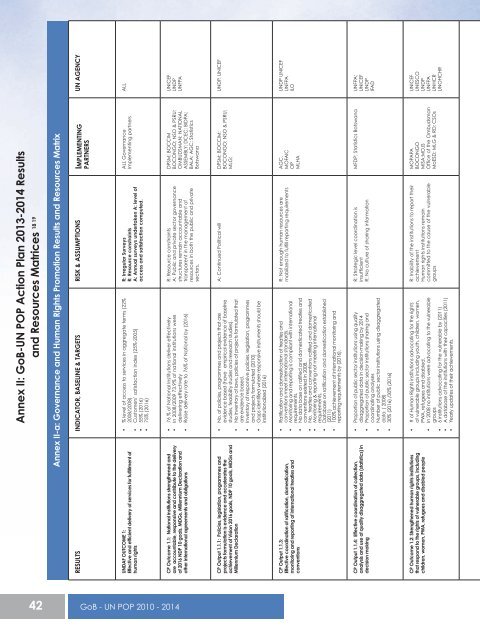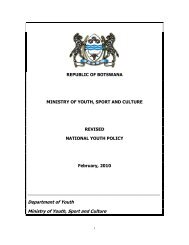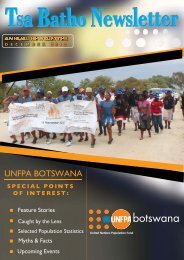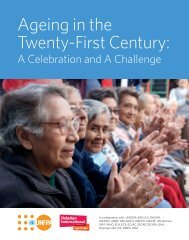Annex II: <strong>GoB</strong>-<strong>UN</strong> <strong>POP</strong> Action Plan 2013-<strong>2014</strong> Results18 19and Resources MatricesAnnex II-a: Governance and Human Rights Promotion Results and Resources MatrixRESULTS INDICATOR, BASELINE & TARGETS RISK & ASSUMPTIONS IMPLEMENTINGPARTNERS<strong>UN</strong> AGENCY<strong>UN</strong>DAF OUTCOME 1:Effective and efficient delivery of services for fulfillment ofhuman rights• % level of access to services in aggregate terms (22%2008/2008)• Customers’ satisfaction index (25%-2005)• 55% (2016)• 75% (2016)R: Irregular SurveysR: Resource constraintsA: Annual surveys undertaken A: level ofaccess and satisfaction computed.ALL GovernanceImplementing partnersALLCP Outcome 1.1: National institutions strengthened andare accountable, responsive and contribute to the deliveryof 2016 NDP 10 goals, MDGs, Millennium Declaration andother international agreements and obligations• 76 % of National Institutions deliver effectively• In 2008/2009 73.9% of national institutions weredelivering effectively• Raise delivery rate to 76% of National by (2016)R: Resource constraintsA: Public and private sector governancestructures remain accountable andtransparent in the management ofresources in both the public and privatesectors.DPSM; BOCCIMBOCONGO; NSO & PSRU;OMBUDSMAN; NATIONALASSEMBLY; DCEC; BIDPA;BALA; AGC; Statistics<strong>Botswana</strong><strong>UN</strong>ICEF<strong>UN</strong>DP<strong>UN</strong>FPACP Output 1.1.1: Policies, legislation, programmes andprojects formulation is evidence and accelerates theachievement of Vision 2016 goals, NDP 10 goals, MDGs andMillennium Declaration• No. of policies, programmes and projects that areevidence based (have empirical evidence of baselinestudies, feasibility studies and research studies).• No inventory of laws, policies of projects formulated thatare evidence based.• Inventory of responsive policies, legislation, programmesand projects formulated (<strong>2010</strong>)• Gaps identified where responsive instruments should beinstitutionalized (2016)A: Continued Political will DPSM; BOCCIM;BOCONGO; NSO & PSRU;MLG;<strong>UN</strong>DP, <strong>UN</strong>ICEFCP Output 1.1.3:Effective coordination of ratification, domestication,monitoring and reporting of international treaties andconventions• Ratification and domestication of treaties andconventions meet international standards.• Monitoring and reporting is compliant with internationalrequirements.• No data base on ratified and domesticated treaties andconventions existed in 2008.• No. treaties and conventions ratified and domesticated• Monitoring & reporting not meeting internationalrequirements.• Database on ratification and domestication established(2011)• 100% achievement of international monitoring andreporting requirements by (2016).R: Not enough human resources aremobilized to fulfill reporting requirementsAGC,MOFAICOPMLHA<strong>UN</strong>DP <strong>UN</strong>ICEF<strong>UN</strong>FPAILOCP Output 1.1.4: Effective coordination of collection,analysis and use of quality disaggregated data (statistics) indecision making• Proportion of public sector institutions using qualitydisaggregated data in decision-making by <strong>2014</strong>• Proportion of public sector institutions sharing andcoordinating analyses• Number of public sector institutions using disaggregateddata ( 2008)• 30% (2016) /30% (2016)R: Strategic level coordination isinsufficientR: No culture of sharing informationMFDP; Statistics <strong>Botswana</strong> <strong>UN</strong>FPA;<strong>UN</strong>ICEF<strong>UN</strong>DPIFADCP Outcome 1.2: Strengthened human rights institutionsthat respond to the rights of vulnerable groups, includingchildren, women, PWA, refugees and disabled people• # of Human Rights institutions advocating for the rightsof vulnerable groups including youth, children, women,PWA, refugees and disabled.• In 2008 no institutions were advocating to the vulnerablegroups• 6 institutions advocating for the vulnerable by (2011)• A database of the institutions with their capacities (2011)• Yearly updates of their achievements.R: Inability of the institutions to report theirachievementHuman rights institutions remaincommitted to the cause of the vulnerablegroupsMOPAPABOCONGOMISA;MDJSOffice of the OmbudsmanMoESD; MLG & RD; CSOs<strong>UN</strong>ICEF<strong>UN</strong>ESCO<strong>UN</strong>DP<strong>UN</strong>FPA<strong>UN</strong>HCR<strong>UN</strong>OHCHR42 <strong>GoB</strong> - <strong>UN</strong> <strong>POP</strong> <strong>2010</strong> - <strong>2014</strong>
CP Output 1.2.1: Human rights institutions strengthened andpromote equality (by gender, minority and socioeconomicstatus) and specific vulnerable groups• No. of Human Rights institutions advocating for the rightsof vulnerable groups including youth, children, women,PWA, refugees and disabled• Number of people benefiting from equality initiatives• No systematic records of the institutions providing/promoting equality• Poor skills level in 2008• A database of the institutions with their capacities (2011)• Yearly updates of their achievementsR: Lack of capacity by the institutions toreport their achievementMOPAPABOCONGOMISA; MDJSOffice of the OmbudsmanMoESDMLG & RDCSOs<strong>UN</strong>ICEF<strong>UN</strong>ESCO<strong>UN</strong>DP<strong>UN</strong>FPA<strong>UN</strong>HCR<strong>UN</strong>OHCHRCP Output 1.2.2: Strengthened justice and social systemshas the capacity to deliver services to all• No. of districts and social justice systems incorporatinge-governance structures• Average turnaround time of cases (reduced from 14months to 7months by <strong>2014</strong>.• % of backlog of cases cleared /resolved by <strong>2014</strong>. In2008/2009 Turnaround time for cases was 14 months• Backlog of cases in 2008/2009 was (TBD)• 6 districts incorporating governance structures by (2016)• Halve turnaround time of cases (2016)• 75% of backlog cleared (2016)R: Resource constraintsA: Resources are mobilized.OP, MDJS, AGCLaw Society of <strong>Botswana</strong>BOCONGOMLG and RDUniversity of <strong>Botswana</strong>Other StakeholdersMLHAMYSC<strong>UN</strong>ICEF<strong>UN</strong>DP<strong>UN</strong>FPA<strong>UN</strong>OHCHRCP Outcome 1.3: Gender mainstreamed in national lawsand policies, and in national, district and community plansand programmes.• Number of laws and policies that mainstream genderinto national, district and community plans• GDI Index (GDI Index- baseline)• GDI – TBDR: Resources constraintR: Lack of skilled personnelMLHA (WAD); MFDP;MoESD;UB; CSOs<strong>UN</strong>FPA; <strong>UN</strong>DP; <strong>UN</strong>ESCOIFADCP Output 1.3.1: Government and civil society organizationshave the capacity and undertake gender analysis andgender responsive programming• Proportion of government and civil societyorganizations who implemented sector specificgender sensitive research, planning, monitoring andevaluations (TBD).• No. of programmes that incorporate criteria andindicators related to gender (0-2008)• % integration of gender issues into national, districtand community development plans (TBD – 2008)• 50% increment by (2016)• All programmes by (2016) have 100% integrationof gender issues into the national, district, andcommunity development plansTo be determined MLHA (WAD); MFDP;MoESD; UB; CSOsIFADCP Outcome 1.4:National institutions have the capacity to manage disasters,risk reduction and preparedness at all levels.• Annual % increase in expenditures for the disasterpreparedness policy development (<strong>2010</strong> expenditures)• Expenditures for the development andimplementation of structures and policies foremergency management (<strong>2010</strong> expenditures).• Number of institutions with disaster management plansin place• 0% (2016)• TBDTo be determinedOP (NDMO) in thecoordination with all theMinistries and Departments;Red Cross; BOCCIM;BOCONGO<strong>UN</strong>DP; <strong>UN</strong>ISDR’ <strong>UN</strong>ICEF,WHO, <strong>UN</strong>HCR, <strong>UN</strong>FPA,<strong>UN</strong>AIDS, <strong>UN</strong>-OCHA,<strong>UN</strong>ESCO <strong>UN</strong>IDOIFADCP Output 1.4.1: Disaster preparedness and responsestrategies, structures, systems and mechanisms developedat all levels• No. of timely Policy briefs on risk management (0-2008).• Proportion of national, district and community levelsvolunteers trained (0-2008)• No. of incidents that result in a significant recoveryeffort (0-2008).• Proportion of planned and implemented public• In 2008 there were no policy briefs• In 2008 there were recovery efforts• 1 per season (<strong>2010</strong>)• 100% of volunteers at national, district, and communitylevels trained; (<strong>2014</strong>)• 50% (<strong>2014</strong>)R: Resource Constraints OP (NDMO) in thecoordination with all theMinistries and Departments;Red Cross, BOCCIM,BOCONGO, DFRR & MLG& RD<strong>UN</strong>DP, <strong>UN</strong>OCHA, <strong>UN</strong>ISDR,<strong>UN</strong>DP, <strong>UN</strong>ICEF, WHO,<strong>UN</strong>HCR, <strong>UN</strong>FPA, <strong>UN</strong>AIDS,<strong>UN</strong>-OCHA, <strong>UN</strong>ESCO <strong>UN</strong>IDOIFADProgramme Component Resource Requirement Estimate: US$ 6,320,000Estimated Contribution by United Nations Agencies: US$ 1,200,000Funding Gap (Resources to be raised): US$ 5,120,00018The matrices are ‘work in progress’ to be refined with the support of the PCMEG paying particular attention to the indicators and targets.19Please note that the budgets reflected in the matrices represents planned spending over the 2013-<strong>2014</strong> period.<strong>GoB</strong> - <strong>UN</strong> <strong>POP</strong> <strong>2010</strong> - <strong>2014</strong> 43







